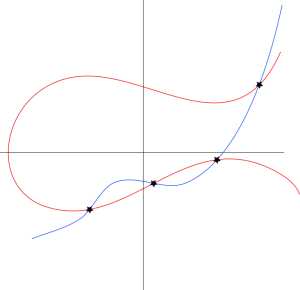Schinzel’s “Hypothesis” for primes is (update: actually, not really, see the remark at the end…) the statement that if is an irreducible polynomial (say monic) in
, and if there is no “congruence obstruction”, then the sequence of values
for integers
contains infinitely many primes. More precisely, one expects that the number
of integers
such that
is prime satisfies
for some (explicitly predicted) constant , called sometimes the “singular series”.
Except if has degree one, this problem is very much open. But it makes sense to translate it to a more geometric setting of polynomials over finite fields, and this leads (as is often the case) to problems that are more tractable. The translation is straightforward: instead of
, one considers the ring
of polynomials over a finite field
with
elements, instead of
, one considers a polynomial
, and then the question is to determine asymptotically how many polynomials
of given degree
are such that
is an irreducible polynomial.
The reason the problem becomes more accessible is that there is an algebraic criterion for a polynomial with coefficients in a finite field
to be irreducible: if we look at the natural action of the Frobenius automorphism
on the set of roots of the polynomial, then
is irreducible if and only if this action “is” a cycle of length
. This is especially useful for the variant of the Schinzel problem where the size of the finite field is varying, whereas the degree
of the polynomials
remains fixed, since in that case the variation of the action of the Frobenius on the roots of the polynomial is encoded in a group homomorphism from the Galois group of the function field of the parameter space to the symmetric group on
letters. (This principle goes back at least to work of S.D. Cohen on Hilbert’s Irreducibility Theorem).
If we apply this principle in the Schinzel setting, this means that we consider specialized polynomials for some fixed polynomial
, where
runs over polynomials of a fixed degree
, but
ranges over powers of a fixed prime. “Generically”, the polynomial
has some fixed degree
, and is squarefree. If we interpret the parameter space
geometrically, the content of the previous paragraph is that we have a group homomorphism
from the fundamental group of to the symmetric group. Then the Chebotarev Density Theorem solves, in principle, the problem of counting the number of irreducible specializations in the large
limit: essentially (omitting the distinction between geometric and arithmetic fundamental groups), the asymptotic proportion of
such that
is irreducible converges as
to the proportion, in the image of
, of the elements that are
-cycles in
. If the homomorphism
is surjective, then this means that the probability that
is irreducible is about
. This is the expected answer in many cases, because this is also the probability that a random polynomial of degree
is irreducible.
All this has been used by a number of people (including Hall, Pollack, Bary-Soroker, and most successfully Entin). However, there is a nice geometric interpretation that I haven’t seen elsewhere. To see it, we go back to and the action of Frobenius on its roots that will determine if
is irreducible. A root of
is an element
such that
where we view as a two-variable polynomial. In other words,
is the first coordinate of a point
that belongs to the intersection of the graph of
in the plane, and the plane affine curve
with equation
. Since the Frobenius will permute these intersection points in the same way that it permutes the roots of
, we can interpret the Schinzel Problem, in that context, as asking about the “variation” of this Galois action as
varies and the curve
is fixed.

This point of view immediately suggests some generalizations: there is no reason to work over a finite field (any field will do), the base curve (which is implicitly the affine line where polynomials live) can be changed to another (open) curve ; the point at infinity, where polynomials have their single pole, might also be changed to any effective divisor with support the complement of
in its smooth projective model (e.g., allowing poles at
and
on the projective line); and
may be any (non-vertical) curve in
. For instance (to see that this generalization is not pointless), take any curve
, and define
. Then the intersection of the graph of a function
on
and
is the set of zeros of
. The problem becomes something like figuring out the “generic” Galois group of the splitting field of this set of zeros. (E.g., the Galois group of a complicated elliptic function defined over
…)
In fact this special case was (with different motivation and terminology) considered by Katz in his book “Twisted L-functions and monodromy” (see Chapter 9). Katz shows that if the (fixed) effective divisor used to define the poles of the functions considered has degree , where
is the genus of the smooth projective model of
, then the image of Galois is the full symmetric group (his proof is rather nice, using character sums on the Jacobian…)
The general case, on the other hand, does not seem to have been considered before. In the recent note that I’ve written on the subject, I use quite elementary arguments with Lefschetz pencils / Morse-like functions (again inspired by results of Katz and Katz-Rains) to show that in very general conditions, the image of the fundamental group is again the full symmetric group. This gives the asymptotic for this geometric Schinzel problem in this generality over finite fields. (In the classical case, this was essentially done by Entin, though the conditions of applicability are not exactly the same).
I recently gave a talk about this in Berlin, and the slides might be a good introduction to the ideas of the proof for interested readers…

As I mention at the end of those slides, the next step is of course to think about the fixed finite field case, where the degree of the polynomials tends to infinity. This seems, even geometrically, to be quite an interesting problem…
[Update: after I wrote this post, I remembered that in fact the (qualitative) problem of representing primes with one polynomial that I consider here is actually Bunyakowski’s Problem, and that the Schinzel Hypothesis is the qualitative statement for a finite set of polynomials… The quantitative versions of both are usually called the Bateman-Horn conjecture. So my terminology is multiply inaccurate…]
Regarding the end remark on the next step. In my eyes, the next step is not to fix the finite field, but rather to consider the error term in the Bateman-Horn conjecture in the large finite field limit. The error term will contain the juicy information how the asymptotic depends on the actual polynomials. (The main term doesn’t give this information as the singular series is independent of the actual polynomials in this limit.)
Yes, this is also interesting! From the point of view of the Grothendieck-Lefschetz trace formula, these are similar points (one needs to understand further cohomology groups beyond the topmost that gives the main term). It depends how far one can go and how precisely one controls them.
The caption of the foto should read “Leibniz” rather than “Leibnitz”. BTW, the Leibniz cookies are named after him, see e.g. (in German) http://www.esskultur.net/zeit/1891-butterkeks.html